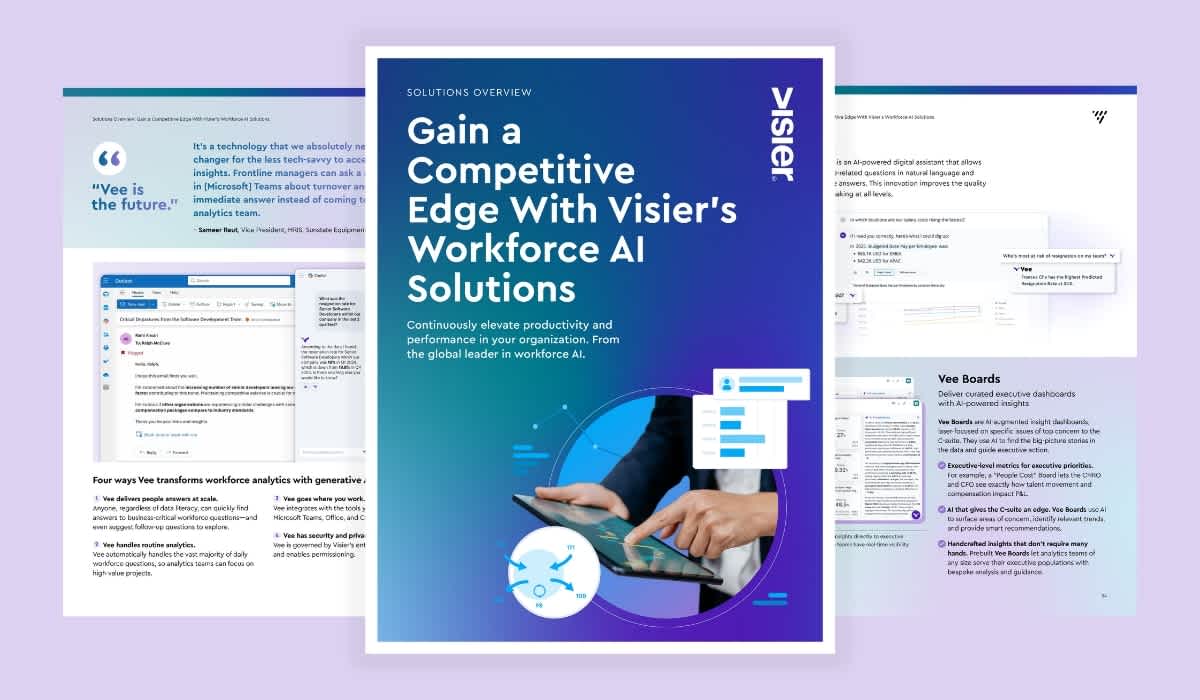Finding a Workforce AI Edge Will Become Every CEO’s Existential Imperative
In an AI-driven world, winning companies will use AI productively. Companies that pretend it doesn’t exist will lose. Get a Workforce AI Edge with Visier. Read how.

The world of work has reached its moment of reckoning. These words sound far too breathless to be taken seriously while also somehow dramatically understating the facts.
Here are the facts:
Historic talent shortages. Decades of structural declines in birthrates have collided with the most valued skills falling in short supply, creating very real sustainability and even existential worries for leaders of organizations across most industries.
Employee disengagement. A global pandemic, years of social crises, growing political and ideological division, and shifting attitudes toward careers and work have led to widespread weariness and dissatisfaction. The great resignation may have subsided, but it’s been replaced by something even more insidious: quiet quitting. In 2023, Gallup found that quiet quitters represent at least 50% of the U.S. workforce.
Slowed productivity growth. Despite sustained periods of massive technological advancement, productivity growth has plateaued at the same time the age of cheap capital has ended. Leaders are under pressure to do more with less, and the global economy is in desperate need of a new productivity inflection point.
Yet expectations have never been higher: investors are equally demanding of both company profitability and growth while new entrants actively disrupt established markets.
This collision of forces has led to a business performance erosion crisis that has CEOs and investors scrambling for answers. The Gordian knot tightens as the current trajectories reveal existential vulnerabilities for individual companies, industries, and even entire economies.
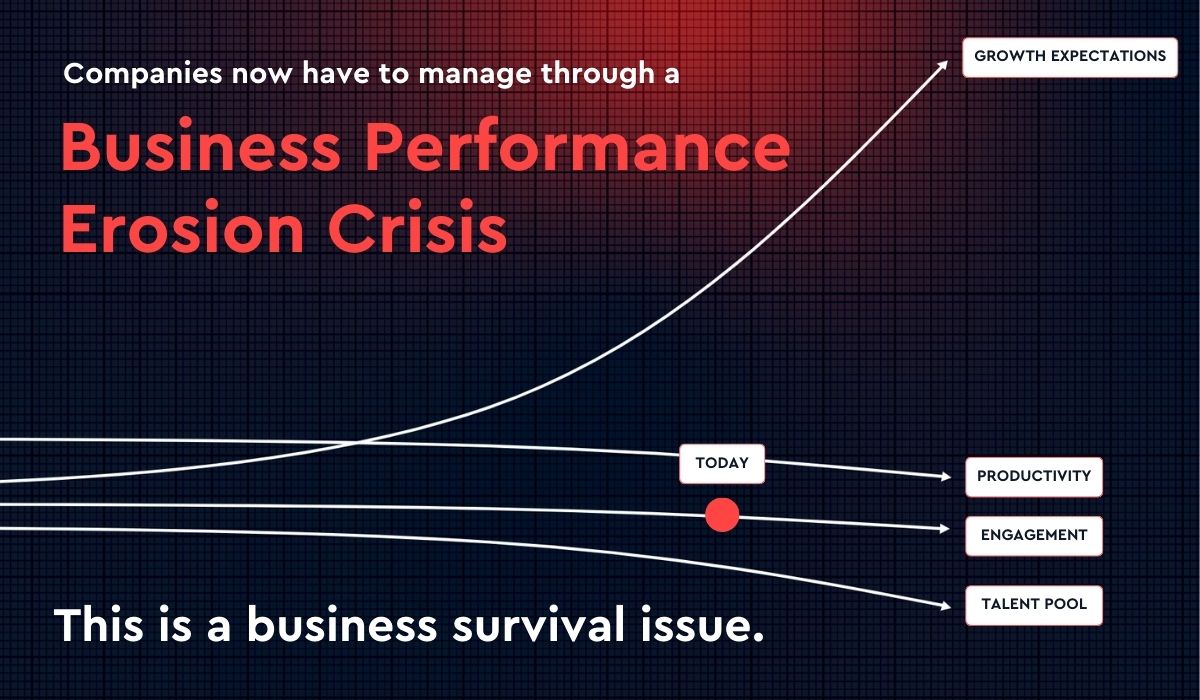
Amplifying the challenge is an accelerating rate of change and pronounced volatility in virtually every economic, social, environmental, and geopolitical arena. Said more simply, if perhaps a bit cliche: The only constant is now change itself.
Few leaders saw a global pandemic on the horizon and fewer still were prepared to navigate the crisis. And that’s just one very conspicuous example. Changes of every magnitude—macro and micro—are increasingly the defining feature of every operating environment. How, then, do you manage a large, complex workforce amid such persistent disruption, crisis, and change?
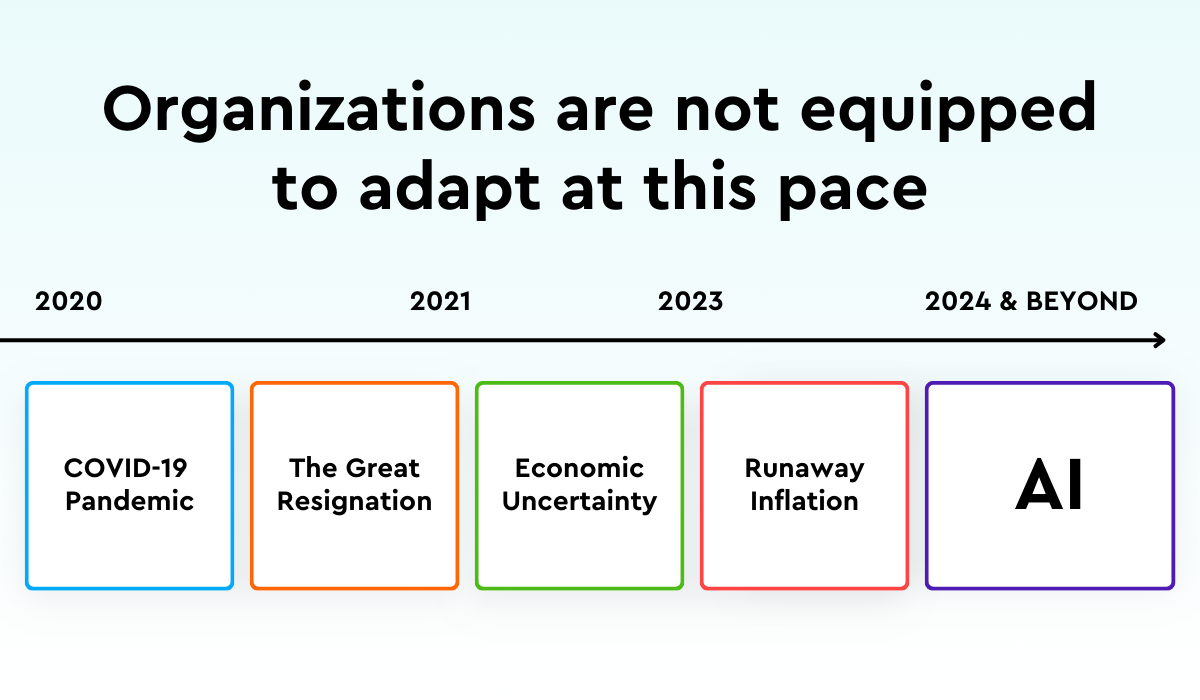
The major change events of the past few years that have impacted the world of work are consequential enough. But the reality is that the next change event–AI–will be the most significant in 100 years. AI will represent both an opportunity and a threat for every company and, in the end, there will be distinctly identifiable winners and losers.
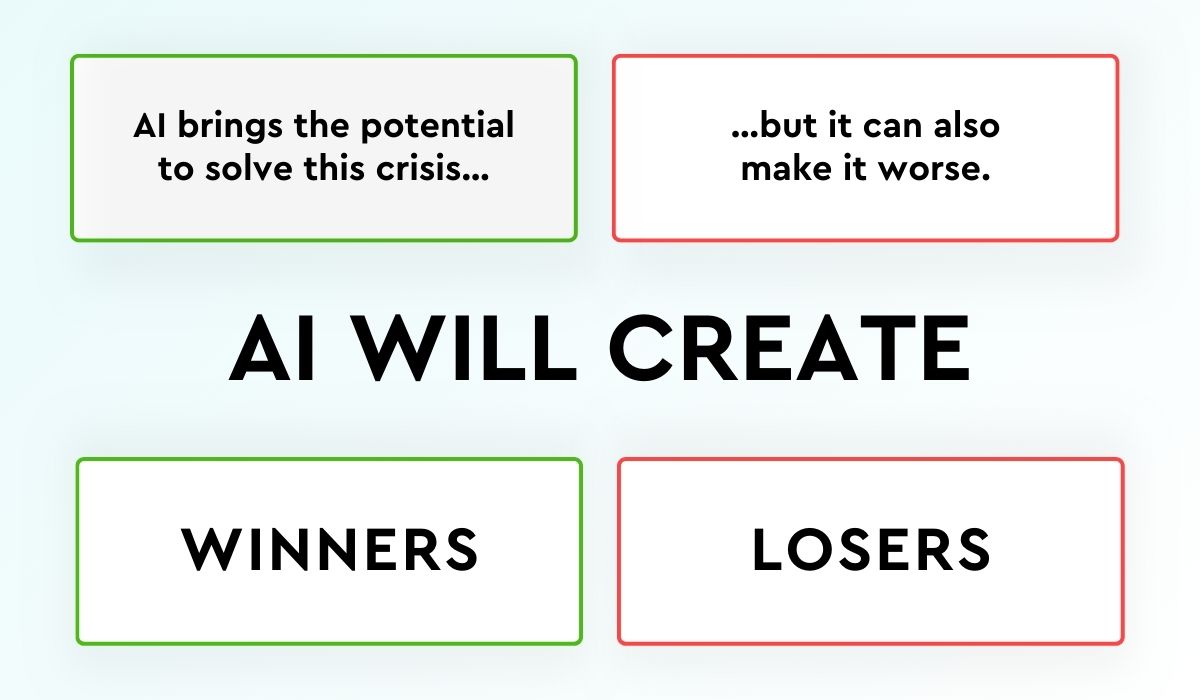
The winners will be companies that put AI to productive use. The losers will be companies that pretend it doesn’t exist, assuming it will eventually disappear like some sort of fast-fashion fad.
Which, needless to say, it almost certainly won’t.

AI to the rescue?
In the world of theater, a deus ex machina is a plot device that allows a seemingly unsolvable problem in a story to be suddenly resolved by an unlikely intervention. Think of the arrival of superhuman powers at crucial moments in every superhero story, chance occurrences in fairy tales, or divine interventions in Greek tragedies. These are all examples of deus ex machina.
But they’re also fiction. (And a bit of a lazy literary device, to boot!) It’s much rarer, but certainly not impossible, to have such a fortunate coincidence of timing in real life.
While AI is still unnerving to some people for legitimate reasons, it’s the closest thing to a real-life deus ex machina for solving the business performance erosion crisis, and spurring the next s-curve of growth for companies, industries, and the global economy.
Let’s return to the facts at the center of this crisis:
Historic talent shortages
When global demography becomes the limiting factor, companies are unlikely to hire their way out of whatever challenges they face. Instead, they need to focus on getting more value out of the talent they have and automating whatever can be automated. Can’t fill a vacant role? Use AI to automate it if you can. Train a human to do it if you cannot. AI opens new opportunities for automating many tasks, activities, and roles that were traditionally seen as innately human. Additionally, the sort of AI capabilities provided by companies like Visier allow managers and leaders to see talent gaps and pathways, align people to roles that deliver the highest impact, develop their skills to fulfill unmet needs, and identify opportunities to migrate human activities to AI automation while also managing a workforce through this transformation.
Employee disengagement
There are many reasons employees become disengaged: ineffective managers, lack of skills development and career progression, repetitive, rote, and unchallenging work, and an inability to see a clear connection between their effort and impact are a few of the key drivers. In each case, AI can play a powerful role in reactivating the collective energy of employees. For example, using Visier’s generative AI digital assistant Vee, managers are able to better understand individuals and teams, making more informed decisions about how people are compensated, trained, and aligned to the highest impact initiatives, while identifying the unobvious pathways that can help develop their careers. Further, AI in general can offload the burden of repetitive and rote tasks and activities that lead to boredom and fatigue, allowing employees to level up to more challenging, differentiating, and fulfilling roles.
Slowed productivity growth
AI has the potential to lift global economic performance by extending the impact of human effort and driving substantially more output and velocity while also allowing people to grow in their careers. Using AI solutions like Visier, people leaders and managers are made significantly more effective in re-engaging employees and reactivating their productivity by connecting the dots between people, the work they do, and desired business outcomes.
Of course, there is also the potential for employees to become displaced by AI. This has been true in every generation of technological advancement targeting productivity improvements since the dawn of the Industrial Revolution. The responsibility lies with CEOs and their leadership teams to strategically calibrate their workforce, taking advantage of the productivity benefits of AI in ways that benefit the business and are also valuable for the employee. Perhaps somewhat ironically, managing the transformation to AI-enabled work will benefit from the use of AI itself: managers and leaders can use tools like Visier’s Vee to guide the way forward for employees and teams, recalibrating the workforce through this and other transformations on the horizon.

How Visier gives companies a Workforce AI Edge
Today’s CEOs are like wartime generals: they’re expected to lead with courage, clarity, and conviction, making a series of strategic bets that will determine the future of their organizations. The rise of AI comes at a consequential moment for companies that are already facing extraordinary pressure to perform despite unprecedented uncertainty and volatility.
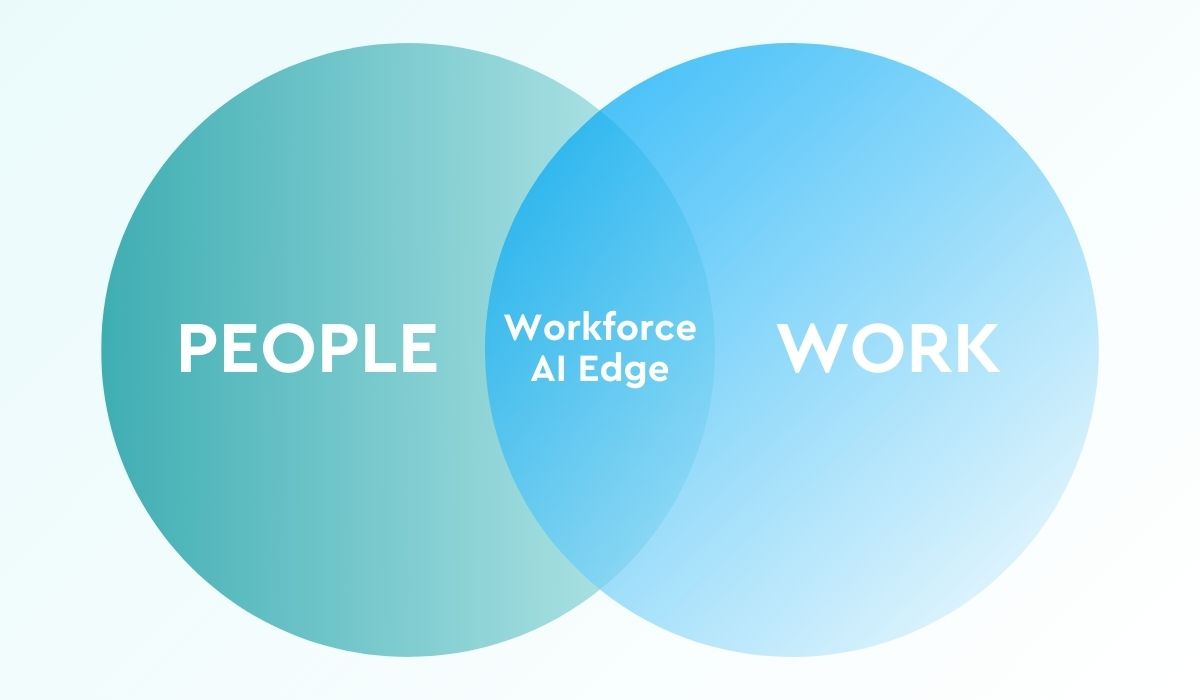
This is why gaining a Workforce AI Edge has to be one of the top strategic mandates for every CEO today. Those that gain this edge will be able to:
Continuously calibrate their workforce, adapt to market, competitive and other environmental shifts, both macro and micro, and ensure employees are aligned to the highest-impact work.
Elevate the performance of everyone by giving managers the tools to lead more effectively, drive better performance from their teams, and find pathways for developing talent and onboarding AI-driven automation in ways that drive the best outcomes for both the business and the employee.
Future-proof their organization by arming leaders with the insights to see around corners, using AI as a strategic advantage for both performance and resilience.
Achieving this requires data you can trust and the ability to connect the dots between people, work, and outcomes. Once you’ve made this connection, you are in a much better position to shape your workforce to drive better performance and outcomes for the business and employees—and, importantly, to adapt quickly as circumstances inevitably change.
Visier’s Real-Time People Data Platform
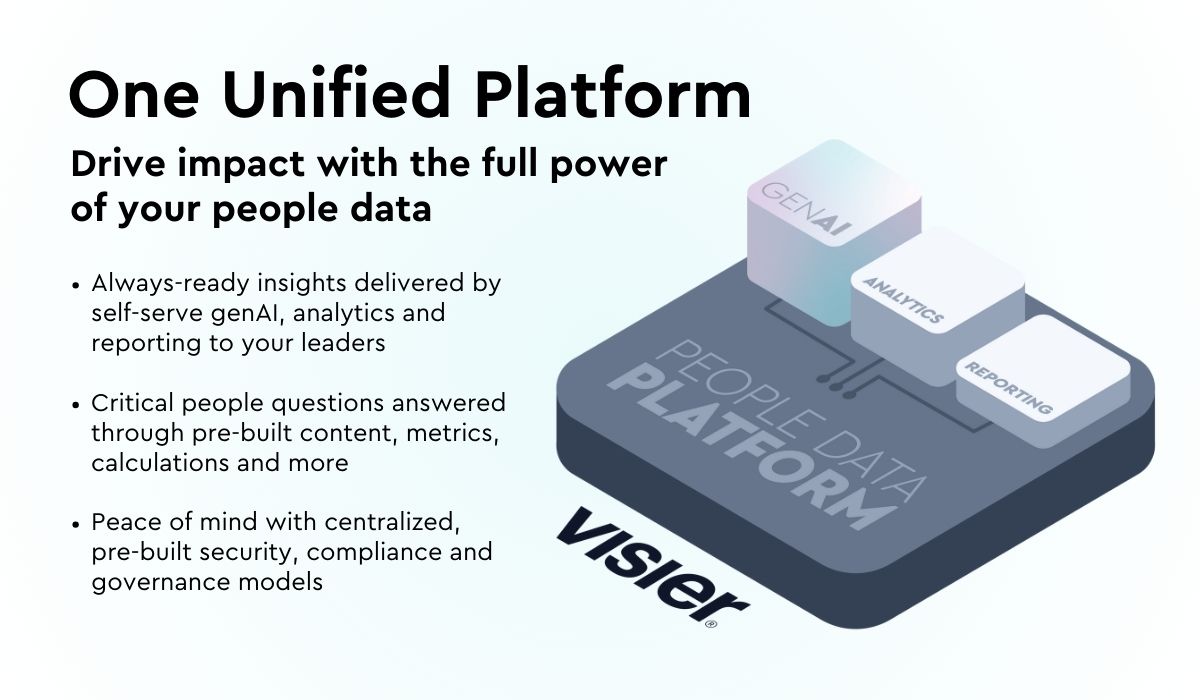
Visier helps organizations achieve a Workforce AI Edge with a powerful set of AI-ready assets and capabilities, including:
AI: Always-ready insights delivered by self-serve genAI, purpose-built to ensure accurate and secure insights scaled across an organization.
Data: Critical people questions answered through pre-built content, metrics, calculations and more. Benchmarks from tens of millions of aggregated and anonymized employee records.
Analytics: Fast and performant consolidation of your people and work data into an always-ready data layer.
Security: Peace of mind with centralized, pre-built security, compliance, and governance models.
Together, these capabilities represent the industry's first Real-Time People Data Platform, which can be used as a turnkey, fully integrated data management, analytics, and genAI stack, or as a powerful set of extensible platform services that seamlessly interoperate with any data fabric, reporting infrastructure, and technology ecosystem.
AI will become the single biggest disruptor to work in many generations, forcing companies to adapt their workforce and skills, their technology, and even their operating models. But neither today’s companies, nor their existing HR tech stacks, weren’t built for this pace of change.
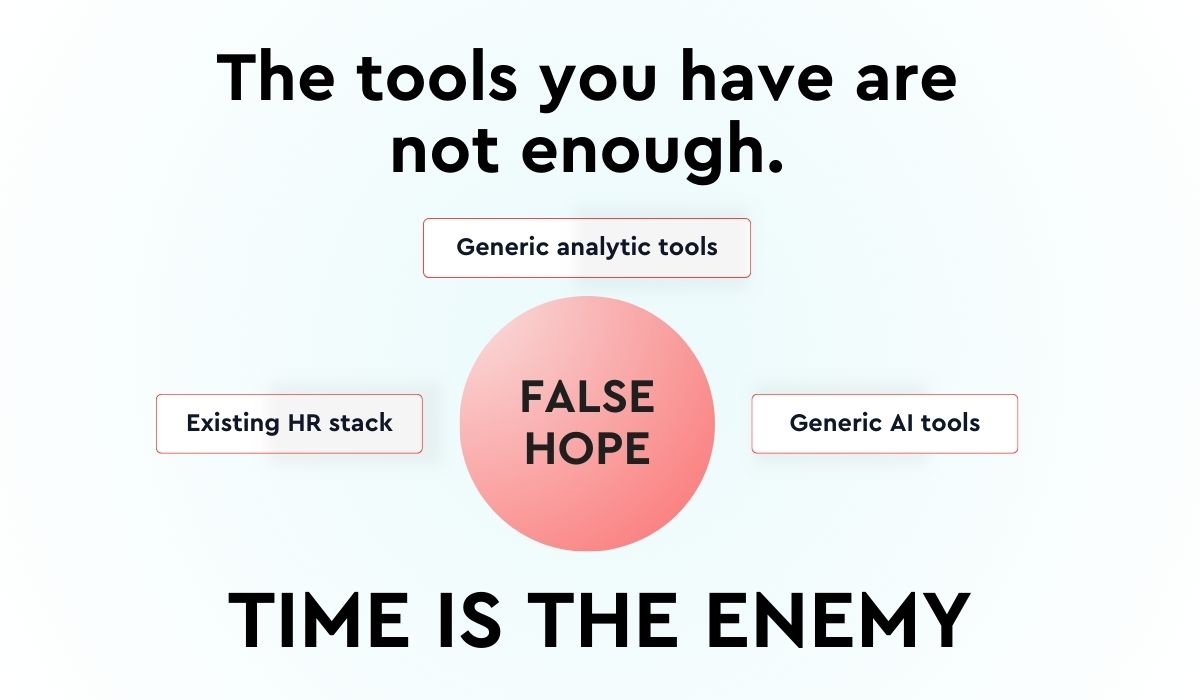
The tools you have are not enough.
Your existing HR stack is a recordkeeping system: designed to capture and store information, not to generate insights
Generic analytic tools (BI tools) can enable faster, more effective analysts, but they’ll do little to help you securely scale the necessary insights and guidance across your organization.
And general-purpose AI platforms introduce security risks. Their accuracy is questionable, and LLMs are designed for dealing with language, not numbers.
You might argue that, with time, these alternatives will evolve, closing the gap on what you need to achieve your Workforce AI Edge. Perhaps. But the real enemy is time. By the time mainstream solutions arrive, you’ll find yourself at a distinct disadvantage. Or worse.
Working together to accelerate AI's impact on the world of work
We’re proud of the considerable role that Visier plays in giving today’s organizations a Workforce AI Edge. But, we also recognize that our impact on a global scale is limited without the collective inspiration, creativity and reach of an ecosystem of customers and partners. So in addition to providing award-winning business-ready applications, Visier is very much Open for Builders. Customers and partners can customize and extend Visier to craft their own AI-driven solutions and workflows; and SaaS companies and solution providers can take advantage of Visier’s People Data Platform to embed reporting, analytics, and generative AI into their commercial applications and solutions.
It’s the collective effort of the entire Visier ecosystem that has the very real potential of significantly impacting and even reversing the business performance erosion crisis.
Now is the time to gain a Workforce AI Edge
It’s easy to grow cynical by what can sometimes feel like an unending cacophony of breathless proclamations about the urgency for change. And we have to be honest with ourselves by saying that we cannot predict the future. But all evidence points to AI as a disruptive force with consequences for business and society equal to or exceeding the internet. Of course, the companies that missed the internet wave did not fare well.
Theodore Roosevelt said “In moments of decision, the best thing you can do is the right thing. The second best is the wrong thing. The worst thing you can do is nothing.” This is a moment for decisiveness. This is a moment to invest in gaining a Workforce AI Edge.


